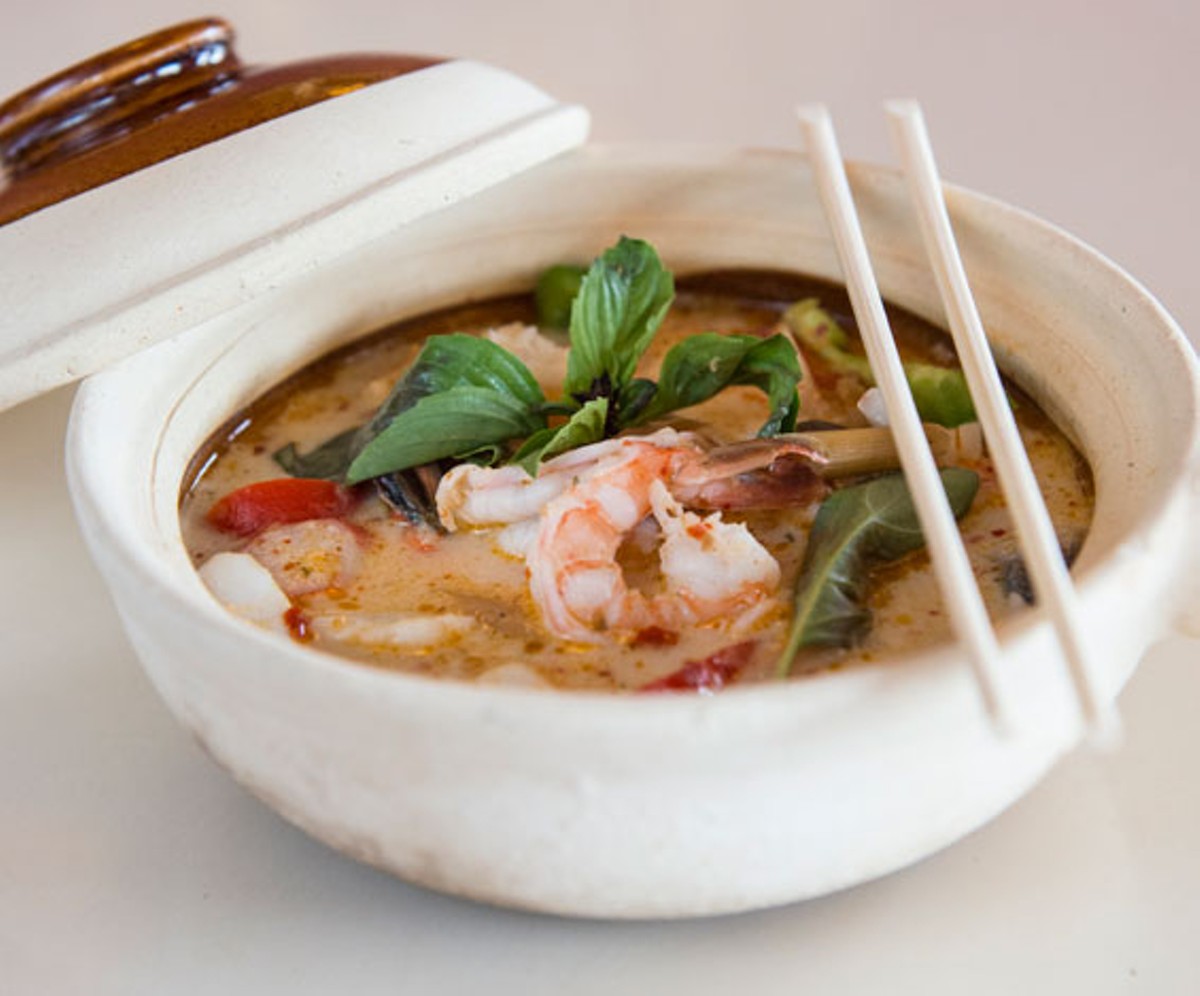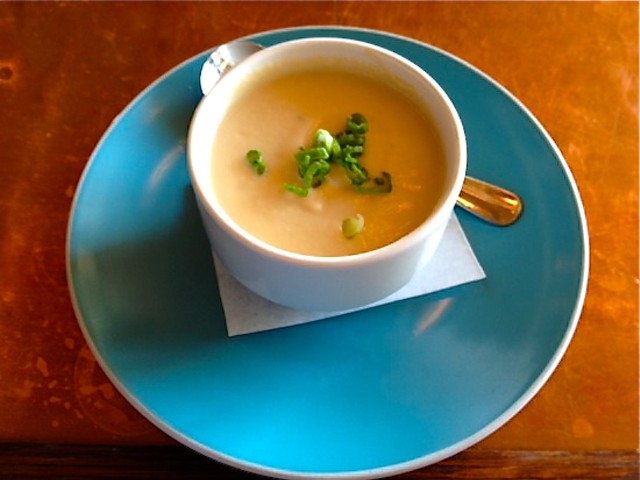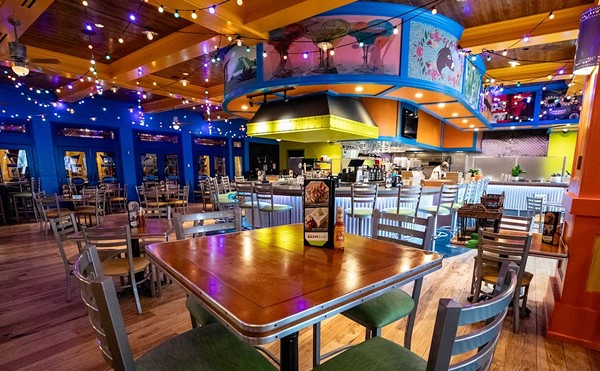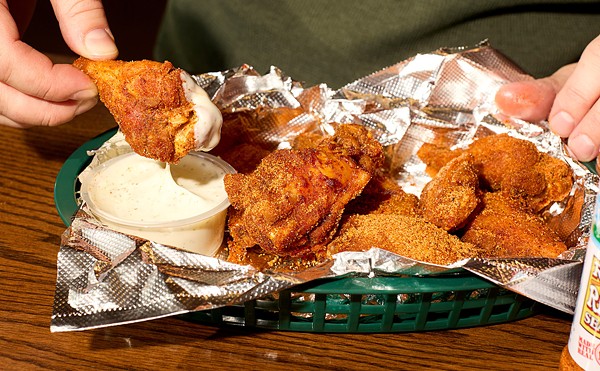When I visited Ocha Thai & Japanese Cuisine for the first time late last year, its name was House of Thai. The sign above the entrance still read Tachibana, the Japanese restaurant that had occupied this west-county strip-mall location for several years. New owners had taken over Tachibana in the spring of 2012. By September they'd transformed it into House of Thai, which (of course) served Thai cuisine but also some Japanese fare, too.
My head reeled. I just wanted some curry. Red, green. I didn't care.
I ordered a red curry, with chicken. It was decent, if blunt in its coconut-milk sweetness. A typical curry in an American Thai restaurant, in other words. My forehead dampened at the default "hot" setting, though. It wasn't Thai-hot hot, but it surpassed don't-scare-away-the-gringos hot. Encouraged, I made plans to return.
When I came back a few weeks later, the Tachibana sign remained above the entrance. Now, however, above the Tachibana sign there was a small but permanent sign for House of Thai. Below the Tachibana sign hung a temporary canvas banner proclaiming that the restaurant — House of Thai, I assumed as I breezed past it — was now open.
If I'd paid closer attention to that banner, my head would have reeled again. Instead, I took a seat. The restaurant looked the same as it had a few weeks before. At the center of the room is a raised platform with freestanding tables. To one side of this are spacious booths. To the other side is a sushi bar. Throughout the restaurant, blond wood framing creates an effect that is either supposed to be a generic rural Japanese village or a special on decking at Home Depot.
The menu did look different. I assumed again that the changes were cosmetic: a heavier stock of paper, lamination, whatever. Yes, I know what happens when you assume, but, dammit, I just wanted a curry. This time, from the list of "House Specials" I chose a red curry with duck. I asked for it "hot." This time the kitchen was tepid with the chiles, and I had to doctor it myself with the chile paste my server offered. Minus the heat, the duck meat's rich natural flavor wasn't enough to balance the combined sweetness of coconut milk and chunks of pineapple. Bell pepper, pale and insipid, added nothing (as is its unfortunate nature).
Slideshow: Inside Ocha Thai & Japanese
I paid my bill. The printed receipt still bore Tachibana's name. Before I drove away, I looked again at the trio of signs. I frowned. I rubbed my temples. The canvas banner didn't merely say the restaurant was now open. It announced that Ocha Thai & Japanese Cuisine was now open.
On my next visit, I learned that new management had made the change at the beginning of February. The menu now features more Japanese entries than it did at first, though the Thai dishes outnumber them. Both the Japanese and Thai menus resemble the Japanese and Thai menus at almost every other Japanese and Thai restaurant in town, and I briefly wondered whether the whole Tachibana-House of Thai-Ocha name confusion might be an elaborate in-joke on the restaurant's part.
The Japanese menu is especially generic: sushi, a few teriyaki dishes, some tempura dishes. Even the selection of elaborate Americanized sushi rolls lacks much pizzazz, with most centered on battered, deep-fried bits. I tried a few pieces of nigiri (salmon, red snapper, yellowtail); the swipe of wasabi paste atop the rice overpowered the flavor of each fish. A spicy tuna roll earned points for using actual pieces of tuna as opposed to the mash-like "scrape" you normally receive, but it was still just a spicy tuna roll.
If the Thai menu doesn't deviate from the standard template, it at least offers more charms than the Japanese one does. The red curry with duck just needs the right level of spice (and fewer chunks of pineapple and wan slivers of bell pepper). Likewise, a hit of chile paste sparked a big bowl of barbecue pork-noodle soup. On its own, the clear broth conveyed a muted porcine essence.
My favorite dish at Ocha was nam tok beef: thin slices of flank steak marinated in a chile-hot, lime-sour sauce and then grilled and served with red onion and cilantro. A side of sticky rice (an extra $2) makes for a complete dish. The marinade's spicy, citrusy notes provide the perfect accents to the steak's natural flavor, while the red onion's crunch contrasts the meat's pleasant chew.
Nam tok beef isn't exotic, but I don't think I've seen it featured so prominently on a menu before. (It's listed first among the house specialties, which is what led me to order it.) It's no coincidence that the most exciting Thai restaurant to open in recent years — one of the most exciting restaurants, period — is Fork & Stix in the east Delmar Loop, which eschews the standard Thai template for a smaller menu featuring many regional dishes I've never seen in this town.
This is the direction Thai restaurants in St. Louis (Japanese restaurants too, for that matter) need to take: more focused, less one-size-fits-all. Otherwise, even with the name confusion settled, I might still mistake Ocha for any of a dozen or two local spots.
Slideshow: Inside Ocha Thai & Japanese






